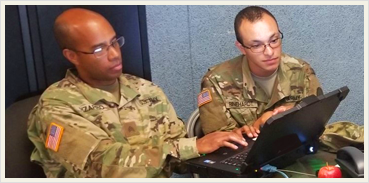
DISTRIBUTED LEARNING 101
Distributed Learning or “DL” is a modern, proven instructional model used by the Army to regularly deliver individual, collective and self-development training and education to Soldiers, leaders and Army civilians anytime, anywhere. Instructors can be blended in to the learning or content can be delivered as stand-alone products.

The Vice Provost for Digital Education (VPDE), leads the way in designing and creating distributed learning products for Soldiers using the latest technologies to distribute and deliver learning, training and certification across a wide array of portable devices depending on the needs and location of the user. VPDE products are user-friendly, pliant and adaptable to the complex and often unique circumstances in which Soldiers live and work.
reference links
DISTRIBUTED LEARNING DECISION CRITERIA

1. Is your content stable? Are the materials subject to frequent
changes and updates?
If the answer is no, then DL may not be the right choice for you. If the
content is subject to frequent changes and updates, consider building the
course on an
LCMS such as the
Lifelong Learning Center (LLC) where content can be updated by the course
manager. Contracted DL may require more time than other options.
2. Does the content require a student’s sense of taste, smell, or
touch?
Taste, smell and touch are not features of Army DL although with the use
of special input devices such as haptic tools, the sense of touch can be
replicated. Generally, if the proposed training requires any one of these
three senses, DL is unlikely to be your best choice.
3. Does the content require an instructor to lead or facilitate the
course?
Research shows that instructor's contact is the most important factor
contributing to DL student success. Contact must be regular (on scheduled
activities) and substantive (have real purpose or objectives) to be of
true value to a student-learner.
4. Does the content require the learner to interact with other
learners?
If yes, consider a blended approach or delivery via the Lifelong Learning
Center where students interact via social media tools or within course
threaded discussions. Student interactions enrich the content by allowing
them to share background and experiences.
5. Does the assessment require a proctor? Someone to provide oversight
on location?
Web based assessments can be secured using a password and login or via
Common Access Card (CAC) authentication to access exams. Although not 100
percent secure, they are considered trustworthy as long as the information
isn’t shared by students. If an on-site proctor is needed then DL may not
be the best choice. Consider sending students to an education center or
classroom for proctored exams. There are some applications that can be
used in the LLC that secure the assessments and should be considered when
making this decision.